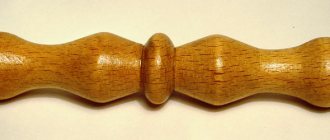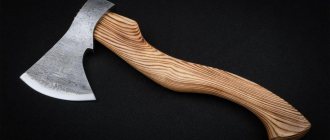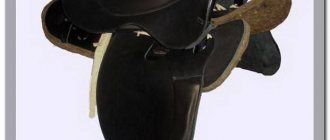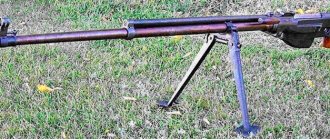The first weapon was a raised stone thrown at a saber-toothed tiger or other terrible beast. It was from this moment that the development of humanity began. It is war that is the engine of progress, dictating the conditions of natural selection for the human race.
Weapons are a guarantee of human survival, the ability to resist external factors and continue one’s lineage. It not only made it possible to hunt, but also to defend against animals, including bipeds. The name of the first weapon is throwing weapons.
Ancient throwing weapons
Back in the Stone Age, man tried to find a weapon that could help him kill an enemy or a large animal from a distance. The first examples of throwing weapons appeared along with the first types of melee weapons. The first throwing hand weapon is an ordinary stone, which is the oldest weapon. Noticing that stones could kill from a distance, people began to practice throwing them. In addition to stones, they also threw sticks.
Unfortunately, the distance over which a stone or stick could be thrown was small, so the first specialized type of throwing weapon was throwing clubs or clubs. Such weapons are still used by some African tribes.
A huge breakthrough in the development of throwing bladed weapons occurred after the invention of the stone ax and spear with a stone tip. Stone axes flew much further than clubs, and spears even pierced the body of an animal or enemy. Noticing that in order to throw a spear, the center of gravity of a spear must be shifted to the tip, ancient people began to make spears of this type. Although at that time spears were not divided into throwing spears and spears for close combat, the universal weapon was perfectly suited for throwing.
Throwing spears over longer distances became possible after the invention of the so-called “spear thrower.” Soon after its invention, a more advanced throwing edged weapon appeared - the bow. Bows were the most effective weapons with which people fought and hunted for many millennia.
Throwing objects at the enemy
Book War Machine: A Guide to Self-Defense"
THROWING STONES . From ancient times to this day, the simplest throwing weapon is a stone. It has long been said: cobblestone is the weapon of the proletariat. Not only because of its accessibility, but also because throwing a stone is quite simple. Whatever part he crashes into the enemy will cause injury to him.
Any master of stone fighting (there are such!) can hit a stone weighing up to 250-300 grams exactly in the head of a person located 50-60 meters from him. But this is a master. An ordinary fighter is unlikely to be able to do the same further than 10-15 meters. However, in normal urban conditions, more is not required.
Turning to stone throwing specialists, we learn that the best shapes are “rounds” (ball-shaped) and “pieces” (irregularly shaped stones with many edges). But flat stones are considered an unreliable weapon, since due to the lifting force generated in flight, they unexpectedly change their trajectory. As for the size, it is better to take medium-sized stones that fit comfortably in your hand. A small pebble won't cause serious damage, but a big one won't throw it very far. You can hold the stone in different ways, as long as it flies out of your hand well. Masters recommend using a three-finger grip: thumb, index and middle.
You can (and should) practice two methods of stone throwing. The first is throws from a short distance, from one to three meters, when they are a simple continuation of the movement of the striking hand. That is, you hold the stone in your hand to strengthen the blow, and at the right moment you unclench your fingers, and the stone flies out of your fist directly into the opponent’s forehead or eye. Almost always such throws come as a complete surprise (there is no swing), and no one has time to dodge them.
The second method is familiar to us from childhood playing snowballs. Of course, you can throw stones not only from above, but also from the side, backhanded, bent over, in a turn, from a prone position. But it’s better not to chase the exotic, but to take the simplest option as a basis, but work it out to complete perfection, and always with both hands (Fig. 157).
Rice.
157. Throwing a stone by hand Practicing throws always begins with the left hand for right-handers and with the right for left-handers. At first, 2/3 of all throws are made with this “lagging” hand. Subsequently, after 30-35 training sessions, the gap in the number of throws with both hands is reduced to 3/5, after another 30-35 training sessions - to 2/5, and after the 100th training session it becomes the same. It is recommended to conduct classes every other day. Start with 10 throws with the trailing hand and 5 with the leading hand. By adding 5 throws to each hand each training session, the total number of throws (one, then the other, and so on alternating) is increased to 100 in one approach. And the total number of approaches should be five. Between approaches there is a break of 20-30 minutes. From the very beginning, try to throw stones with full force. To prevent injuries to the elbow joint and muscle strain from unusual loads, start with small stones and massage the muscles and joints of your arms well. Every time you increase the distance to the target (initial - 3 meters, final 10-15), as well as when moving to heavier stones, bandage the elbow joint with an elastic bandage. If you feel the need, then bandage the other joints - the shoulder and wrist. After working 5-10 workouts in bandages, you can remove them. But since sprains and dislocations are bad things, it’s better to be safe than to be out of commission for a long time. During throws, your legs should be bent at the knees so that you stand lower than your head. The body should be relaxed, tensing only as necessary. Change the position of your feet in relation to the target each time. Otherwise, you will develop a bad habit of hitting it only with a certain position of your legs. Dedicate every third training session to simulating a fight with several opponents, placing 3-6 targets around you, at different distances from the center of the site. While throwing stones at a group of “opponents,” continuously move, turn, imitate dodging objects flying at you, and crouch. When throwing, you need to look at the target, and not your hand with the stone. The hand must itself choose the trajectory of the swing and the strength of the pushing impulse. This process occurs automatically, so the more you focus your attention on the goal, “forgetting” about your hand, the better. Experts believe that the skill of throwing a stone in a specific way is developed after approximately five thousand repetitions with each hand from a certain distance. Naturally, in compliance with all the requirements listed above. THROWING STONES USING DEVICES .
The oldest among them is the sling. This is an ordinary belt folded in half. A stone is placed at the bend, then the belt is untwisted over the head and at the right moment one end of the belt is released. The stone flies towards the target. In ancient times, slingers caused serious damage to an armored enemy at a distance of up to 180 meters, and hit the target at a distance of up to 300 meters! True, their slings had a woven or sewn widening in the middle of the belt, with a recess for a stone. In addition, one end of the combat sling was equipped with a loop, which served to more conveniently hold it during the release of the projectile. A good slinger never missed a standing person by up to 70 meters, hitting him with a stone or lead bullet directly in the forehead (Fig. 158). Rice.
158. Throwing a stone with a sling If we talk about self-defense, then it is quite enough to learn how to throw stones using a homemade sling (turning a trouser belt into it) at least 10-15 meters. “One has to be surprised that such a simple device, which can be arranged using home remedies, has not yet found use among our “physical culturists”*. SLINGSHOT . This is the name of a well-known device, which about forty years ago no self-respecting “street” boy in our country could do without. Thanks to children's films, adults' attitude towards the slingshot is rather ironic. And completely in vain. Of course, this is not a sling, not a crossbow, not a bow, but its damaging effect is quite high. A steel ball from a bearing, fired from a good slingshot, pierces a human skull from a distance of 15-20 meters and gets stuck inside the head. With all the consequences that flow from this fact. Naturally, instead of steel balls, you can shoot small stones. It is not difficult to knock out an eye with a slingshot or knock you down with a hit to the forehead or temple, since it is convenient to conduct aimed fire from it. In addition, the slingshot is portable, you can carry it with you in the pocket of your jacket, jacket, coat, in an attaché case, in a sports bag, along with a case containing a small supply of round stones or steel balls. KNIFE THROWING .
Everyone knows from movies that throwing a knife at a person can kill him. Our scouts in old films “about the war” famously shot down German sentries, hitting them in the neck from about fifteen meters away. In fact, the main distance for throwing a knife is 5-6 steps, which is 3.5-4.5 meters (standard “step” is 71-72 cm). Only in this case the enemy receives a blow without having time to dodge, deflect, crouch, fall, or close. The greater the distance to the target, the more difficult it is to calculate the trajectory and the required number of rotations of the knife along the longitudinal axis. And on the contrary, if the distance does not exceed 5-6 steps, then the knife, after leaving the hand, only manages to make half a turn in the air and enters the point of destruction with its tip. Further 10 steps the circus performers throw the knife in the arena. The point of throwing is not only to prevent the enemy from getting closer. The damaging force of a knife when thrown is almost twice as great as when thrusting with a hand. Special experiments have shown: by thrusting a knife into a shield made of boards, fighters pierce the wood by 16-17 mm, and when throwing - by 27-28 mm! A throwing knife differs from a regular knife in several ways. The most important difference is that its center of gravity is exactly in the middle or shifted to the tip. In addition, a special throwing knife usually has an extension of the blade towards the tip. The point is well sharpened, while the blade from the flare to the handle can remain dull. There is no guard so as not to slow down the flight. These knives themselves are usually made by stamping; the handle - in the exact sense of the word - is most often absent. It is replaced by a notch. Often, on the side where the handle should be, a wide slot is made in the metal. It’s more comfortable to hold it this way, and it’s easier to ensure a shift of the center of gravity towards the tip. Of course, you can throw an ordinary knife (dagger, cleaver, stiletto, bayonet), as long as it satisfies the basic requirement: the blade is at least a little heavier than the handle (Fig. 159). Rice.
159. Throwing knives There are various ways to throw a knife - from the side, from below, backhand, lying down, from behind cover.
But the simplest, at the same time the most powerful and effective - throwing while standing, from behind, with a grip on the blade. To do this, you should take the knife blade with your right hand so that the handle is directed forward, with the blade to the left, the thumb lies on top of the knife, and its axis is a continuation of the axis of the forearm. The remaining fingers hold the knife from below, without touching the tip. Take a left-sided fighting stance: right hand in front of the chest, its forearm vertical (i.e., the arm is bent at the elbow at a right angle), the handle of the knife is directed upward. The left arm is slightly bent and extended forward. Then, bending at the waist, swing your right hand up and back over your shoulder without bending your wrist. Keeping the forearm, thumb and blade on the same line, sharply straighten at the waist and straighten your right arm, without additional force with your hand, send the knife with the handle to the target. The blade must be released at the moment the arm is fully straightened along the aiming line (Fig. 160).
Rice.
160. Throwing a knife from behind the shoulder The main requirement that must be observed when throwing a knife is not to allow a whip with the hand and not to let the hand fall below the level of the target.
You also can’t “get hung up” on the desire to hit the target at all costs. The body should be relaxed, knees bent, breathing down (breathe not from the chest, but from the stomach), and at the moment of the throw, exhale lightly. With this method of throwing, a knife 25-30 cm long makes one half-turn at a distance of 3-5 meters. The accuracy of hitting with the tip of the blade largely depends on where you hold the blade. The closer the thumb is to the handle, the greater the distance to the target should be, and vice versa. Each fighter determines the best throwing distance and place for gripping the blade during training using trial and error methods. To defeat an enemy at a distance of less than three meters (2-4 steps), you can throw the knife with the blade forward. In this case, it is held by the handle, blade to the left, thumb on top. The starting position and throwing technique are similar to throwing the handle forward (Fig. 163, 164). When practicing the technique of throwing a knife, you need to pay attention to the position of the weapon in your hand and the distance to the target with each throw. If the blade does not stick into it, but hits flat, change the location of the thumb, shorten or increase the distance. The average number of training sessions to develop the skill of hitting a target from a standing position 3-5 meters from the target is 25-30 (classes every other day), 30-35 minutes each training session. Longer training does not make sense, as severe fatigue of the shoulder joint occurs. Then you need to complicate the training. In particular, move on to throwing several knives in a row at targets located in a fan at different distances - from two to five meters. In addition, you need to study the technique of throwing on the move, without stopping to throw (Fig. 161, 162).
Rice. 161. Throwing knives in several directions Fig. 162. Practicing the accuracy of hitting a person Fig. 163. Methods of gripping a knife by the blade Fig.
164. Methods of gripping a knife by the handle Throwing nails .
A knife is a multi-purpose weapon. But not everyone has one, especially one that is suitable for throwing. It is much easier to use large nails, 15-20 cm long, for this purpose. You can buy them at any building materials store and carry five or more with you at all times. Nails are generally good for self-defense, which will be discussed later. I only recommend making them heavier at one end by wrapping them with electrical tape near the caps (it’s more convenient to hold them this way). The flight speed of a weighted nail increases and the impact becomes stronger. However, you can do without weighting (Fig. 165). Rice.
165. Methods of gripping long nails Throwing a nail is practically no different from a knife. As with him, you can only find a throwing style that suits you, consolidate it as a skill, and practice it in different applications only through practice. Nevertheless, I will try to give some tips that are useful for a novice thrower: ♦ The most common mistake of beginners is the desire to put more force into the throw instead of focusing on the coordination of movements. ♦ At the moment of the throw, the left hand must be pulled back, and the body weight must be transferred from the right leg to the left. At the same time, the body turns from the side stance (left side forward) to the front one in relation to the target. ♦ The movement of the hand and the whole body must be interrupted, as it were, at the moment the nail (and knife) leaves the fingers in order to transfer the entire impulse of movement to it. But no whipping with a brush! The fingers should open with a click-like movement. ♦ Aim and throw with anticipation above the point intended to hit, along an imaginary vertical plane connecting the center line of the thrower’s body and the middle of the target. If the target is as tall as a person, aim for the chest or throat, and release the weapon from your fingers at eye level. The thrower should, as it were, reach out with his hand after the flying nail (knife). ♦ The transfer of body weight from the right leg to the left, the rotation of the body, the opening of the fingers, the reaching movement of the hand, all this should be continuous, like the splash of a wave. The harmonious sequence of all elements of the technique, their non-division, is very important. Aim and throw nails, knives and other objects during training only at targets and never at people. Such jokes are typical of idiots. Make targets from soft wood, straw, turf, thick foam rubber and other materials that prevent ricochet. MICRO DART . One of the favorite projectiles of today's schoolchildren is a nail up to 10-12 cm long, the head of which is located inside a piece of plasticine. On the opposite side, evil children stick a bird feather (chicken, goose, crow) or a paper stabilizer into the plasticine. Such a projectile is thrown like darts over a distance of 6-7 meters. It sticks into the target (for example, into the opponent’s face) regardless of the starting position from which the throw is made. Injury when hit can be serious, as the force of the impact is quite high. Less powerful throwers are made from pins. For this purpose, a pin is inserted all the way into an ordinary eraser, so that its point sticks out on the other side of the eraser. In this case, a stabilizer made of a piece of paper or some kind of ribbon is attached to the eraser with a pin. It won’t kill, of course, but if it sticks in the eye, cheek, nose, even arm, the pleasure will be below average. It’s even easier to make metal using a student’s pen. But now it’s hard to find a pen for ink, everyone has switched to ballpoint pens. OTHER PROJECTILES .
In principle, you can throw anything at the enemy’s head or body: bottles, wine glasses, glasses, glasses, axes, sickles, hammers, plates, sapper blades, pieces of glass, stools, and so on (Fig. 167). For reasons of accessibility, I would like to draw your attention to three types of throwing weapons: pieces of window glass, plates, and axes. These are items that are very often at hand. The aluminum plate is still used in prisons and army canteens. Prisoners, using plates sharpened on the rim, more than once removed sentries during escapes. But even an unsharpened ordinary earthenware plate is a rather dangerous weapon. If anyone doubts this, let him ask to throw such a plate into his stomach (I don’t say in his face) from close range. It won't seem enough. Meanwhile, larger or smaller plates, saucers, glass round trays are found everywhere, even in official institutions. True, it is better to learn to accurately throw a metal or plastic plate at a target.
Rice.
167. You can throw any objects. AXES , like plates, are among the most common objects.
In any village house, dacha, setting, camping trip, logging site and many other places there will definitely be an ax. From books about American Indians, everyone knows about their tomahawks - small hatchets with a long handle. The Indians threw them at a distance of up to 80 meters, and within 15 meters they always hit the target. The axes that are common in our country, regardless of their purpose, have a shorter (compared to tomahawks) ax handle and a large blade. However, even with such a weapon it is not difficult to hit a person if he is no more than five meters from the thrower. A skill would be developed. Like a knife, the ax must be released from the hand at the moment when it forms a straight line with the forearm. The throw is made not with the hand, but with a powerful straightening of the lower back and movement in the shoulder joint. The main thing is not to allow the hand to whip and not to let the hand fall below the level of the target when releasing the ax from the fingers. The throwing range depends on where the ax is held. The closer the hand is to the blade, the greater the distance to the target should be. But if you are not a professional, then do not try to throw the ax further than five or six meters. Otherwise, you will simply give your weapon to the enemy (Fig. 166).
Rice.
166. Throwing an ax requires a special skill. GLASS , as you know, is lying around everywhere. It is not on the ground, it is easy to get by breaking any window, display case, lamp, cabinet door, glass, etc. Pieces of glass with a number of sides from three to six (with a side size of no more than 9-10 cm) are most suitable for throwing. For training, it is better to use metal (or plastic) plates with pointed edges and corners rather than glass. They are thrown in the same way as a knife - from behind the shoulder, held in a vertical plane. You can throw pieces of glass horizontally, backhanding from the chest, but then the distance to the target should not exceed three meters. Otherwise, it is very difficult to get to the intended point: the plane of the glass creates an aerodynamic effect during flight (wing lift) and it can fly anywhere. A sapper shovel is a very good throwing weapon, but you won’t carry it everywhere with you, for example, to a dance, to a cafe, or on a date with a girl. By the way, the issue of carrying edged weapons is important. A lot depends on how discreetly it is placed, how conveniently it is worn, and how easily it is grabbed. In particular, the life of its owner. Experts recommend the following places for placing small piercing and cutting objects: forearms, shins, on the back near the neck, on the side of the thighs. There are two types of placement methods - with an elastic band or adhesive tape directly to the body and in special covers hemmed on the inside of the clothing. For example, a set of throwing knives (nails) can be conveniently carried in a case near the collar of a jacket (jacket, coat, raincoat). In this case, raising your open palms up and showing the enemy that you have nothing, you suddenly snatch your weapon from behind your head and throw it at him. In any case, this is exactly how I was taught to respond to the command “hands up!” Another good place is the inside of the left forearm (for left-handers, the right). But carrying any weapon, both bladed and firearms, in the back of your belt is wrong. If you find yourself close to an opponent or surrounded by hostile people, you may not be able to draw. To do this, one of the enemies will only have to grab your hand at the belt and hit you harder a couple of times.
Antique throwing weapons
Ancient hand-held throwing weapons that were used in antiquity were very diverse. It was in ancient Greece that the first sports throwing weapons appeared. In addition to a variety of bows, spears and darts, slings were widely used in Greece. Despite its inconspicuous appearance, the sling was a very formidable weapon. Modern research carried out in Africa (one of the tribes of which still uses slings) has proven that a projectile fired from a sling flies at great speed.
The sling is the favorite throwing weapon of the Spaniards, or rather the inhabitants of the Balearic Islands, which were located a little east of Spain. Balearic slingers were one of the best light skirmishers in Ancient Greece. Thanks to training carried out since childhood, slingers not only easily hit the enemy’s head, but could also hit a certain place on a person’s face. Heavy cannonballs even pierced helmets and armor.
The most powerful types of bows in Ancient Greece were those of archers from Crete. Only they could compete with the Balearic slingers.
The first siege engines, which are classified as throwing weapons, also appeared in Ancient Greece.
Ancient Roman throwing weapons
A review of the throwing weapons of Ancient Rome should begin with the spears, which were called “gasta”. It was from them that the name of the Roman units “hastati” came from. The Roman “gasta” spear had three types, only the light spear was intended exclusively for throwing. When the Roman soldiers received new spears, the piluma, instead of the hasta, light throwing spears remained in service with the vellites (light Roman skirmishers).
In addition to traditional throwing weapons (spears, slings, bows, etc.), the Roman army used many types of military throwing machines.
Roman troops used the following types of military throwing vehicles:
- Onagers;
- Ballistas;
- Catapults;
- Scorpios.
This classification does not give a complete picture of the variety of military throwing machines of the Romans, but will help to get a general idea of them.
Gods of war
The ancient artillery park contains countless numbers and variety of deadly fauna, which can only be described in several volumes. But there is a classification of all throwing machines according to the principle of operation into three large groups:
- Tension group. This is a method of launching a projectile due to elastic deformation of the working elements of the structure (for example, a bowstring and shoulders). This method is used by some ballistas, as well as bows and crossbows.
- Torsion group. Combat cocking occurs by twisting ropes or animal sinews into a kind of “pigtail”. A lever is inserted between the ropes and the twisting begins. Such a rope system works like a spring: when a certain compression force is reached, the twisting lever is knocked out and the technique fires a charged projectile. Such machines were more complex and were invented later than the tension method.
- Gravity group. A counterweight is raised to a certain height, after which a lever is dropped and pulled down, which ejects the projectile. This method began to be actively used at the end of the era of “wooden artillery”, before the invention of gunpowder cannons. The most powerful siege weapons were invented in France and were called trebuchets. A salvo from such a vehicle could deliver a body weighing 650 kg beyond the walls of an enemy castle; the reload time was appropriate.
But the combat mechanisms were bulky and extremely inconvenient to transport, so when gunpowder artillery appeared, they quickly left the battlefield.
Ancient hand-held throwing weapons of the East
In the East, the main throwing weapon at all times was the bow. The eastern onion, unlike the simple European onion, was a complex composite product. In this regard, it was distinguished by its lighter weight and size, although it had a power that was 30 percent greater than even English bows - the most powerful in Europe.
Eastern sedentary and nomadic peoples were unsurpassed masters of archery. Hitting an enemy in the eye at a great distance was never a sign of great skill among the nomads. Although the Asian bow was an excellent weapon, it was quite difficult to manufacture it, since it required compliance with a large number of technological aspects.
In addition to bows, throwing spears and darts were widespread in the East. Throwing knives were also often used by eastern warriors.
When considering the throwing weapons of the East, one cannot fail to mention Indian throwing weapons. In addition to traditional types, a rather specific throwing weapon, the chakra, was widespread in India. This weapon was an iron ring, the outer edge of which was sharpened to a razor sharpness, and the inner edge was blunt. Unlike Japanese shuriken, these weapons were used openly, mainly on the battlefield. Only the most skilled warriors of noble birth, who studied this art from childhood, owned chakra. The inept warrior was afraid to use chakra, since if mishandled, it posed a great danger to its owner. But those who wielded this weapon professionally could easily cut off the heads or hands of their enemies with chakra.
Medieval throwing weapons
Medieval throwing weapons were very diverse. The most common throwing weapons of the early Middle Ages were:
- Bows, which were most often simple (but there were also composite ones);
- Throwing spears. In addition to standard throwing spears, the Franks had a common spear of the “angon” type, which was a slightly modernized version of the Roman “pilum” spear. “Angon” was intended for the same purposes as the “pilum” - it was thrown at the enemy’s shield, forcing him to throw away the shield, which had become heavy and clumsy;
- Crossbows appeared around the 9th century and immediately won the title of “weapon of the devil”, since a crossbow bolt easily pierced knightly armor of the highest quality. Despite the Vatican's disapproval, the knights quickly appreciated the advantage of this weapon. Unfortunately, the rate of fire of crossbows left much to be desired, so bows were considered a more effective weapon.
Individual throwing
Everyone knows the bow and crossbow. It can be added that the crossbow was invented later, it required less physical strength to shoot, and, accordingly, less time was required to prepare the shooter.
It was more accurate and penetrated armor more effectively, but the rate of fire left much to be desired. Crossbow projectiles are called bolts or darts. Less known is the Chinese multi-shot crossbow Cho-ko-nu, invented in the second century AD; according to some sources, it was found in the burials of warriors BC.
Cho-ko-nu looks like a regular crossbow, but has a wooden or, less often, metal magazine mounted on top. Shells are poured from above and the shooter can only cock the bowstring and shoot. The rate of fire is much higher than that of its analogues. Interesting fact: the last combat use was in the Sino-Japanese War of 1894/95.
A javelin thrower is a simple wooden niche into which a small spear is inserted for throwing.
It works as a lever that enhances a person’s muscular energy when throwing a projectile.
The Romans, who had their own way of waging war, began to use spear throwing on a large scale. The weapons arsenal of spears was diverse, and to use them for their intended purpose, such a simple device came into use.
A sling is a rope or belt into which a projectile holder or twisted basket is sewn. A projectile is inserted into this place, the sling is spun over the head or to the side of the thrower, and the projectile is launched at the enemy.
One end of the sling has a loop into which the slinger’s hand is threaded, and at the second he holds the sling while unwinding and releases it. Precision shooting is possible at a distance of 70 meters, and the heavy projectile is a very serious weapon.
The Romans used a lead ball as a projectile, while the Incas used gold ones. Mostly round hewn stones were used. Historians also did not attribute the invention of the sling to anyone in particular, but references to it come from the ancient world.
Japanese throwing weapons
Among the huge number of throwing weapons in Japan, there were also specific samples that were characteristic only of this region. The most common (thanks to Hollywood films) throwing weapons in Japan are various throwing stars or shurikens. Contrary to popular belief, they were not considered lethal weapons, but served to distract the enemy in battle.
The shuriken could not be deadly for one simple reason - it was light enough and could not stick deep enough. To inflict a mortal wound. Japanese ninjas quickly found a way out of this situation - their shurikens were smeared with poison, so any scratch could cause a painful death.
Despite the fact that many are accustomed to representing shuriken in the form of a “star,” shuriken in the form of arrows were extremely popular in Japan. It was the throwing arrows that came to Japan from China that became the prototype for the famous ninja star.
North American Indian throwing weapons
The Indians of the American prairies, whose life was a series of dangerous hunts and skirmishes with other nomadic tribes, used knives and axes for throwing (in addition to traditional bows and spears). Although small throwing axes were brought by Europeans, the Indians quickly appreciated their effectiveness and learned to throw them masterfully. It is worth noting that the battle ax was thrown, as a rule, only at the back of the fleeing enemy, since the flying ax could be easily dodged. If the Indian warrior had no other weapon other than a steel tomahawk, he did not throw it.
Classification of throwing weapons
All throwing weapons can be divided into two large classes:
- The first includes weapons that hit a target using human muscle power;
- The second class includes those types of weapons that hit the target with a projectile, while the weapon itself remains in the hands of its owner.
This classification classifies all spears, axes, knives, clubs and other similar weapons as first class. The second class, according to the classification, is represented by bows, crossbows and throwing machines. In addition to these two groups, this classification identifies an intermediate group, which includes the sling.
Throwing knives and techniques for using them
The first throwing knives appeared back in the Stone Age, when primitive man began to throw a stone chopper (which was the first knife) at a fleeing animal. Since in the Stone and Bronze Ages, as well as in the Middle Ages, there were enough other, more deadly weapons to hit a target at a distance, throwing knives were very rare. In those days, they were used mainly by robbers, hired killers and various kinds of swindlers. Professional warriors who spent their whole lives in battles knew how to throw not only knives, but also any weapon that came to hand.
With the advent and spread of compact and rapid-fire firearms, throwing weapons lost their relevance and began to rapidly lose their positions. In this regard, the military remembered throwing knives, which for many centuries were quite exotic weapons.
Special throwing knives took their place in the arsenal of professional intelligence officers and spies, for whom the ability to throw a knife was a necessary skill that could save lives in a difficult situation.
Many modern schools that teach throwing knives often keep silent about the fact that the traditional reverse throwing technique is practically useless in a real situation. Moreover, by throwing a knife in a stressful situation, you can lose your only weapon, which may not even stick into the target, and if it does stick, it will cause minor damage.
Real combat knives are thrown only using the non-revolving throwing technique. For this, the knife must be heavy, and the distance must be about 2 meters. Some professionals throw knives at 10 meters, but for an ordinary person familiar with the technique of non-revolving throwing, the optimal distance for confidently hitting a target is 1.5-2 meters.
Before mastering any throwing technique, you need to purchase or make a special throwing knife. It is, as a rule, all-metal and does not have any lining in the handle area. Training with throwing knives. Under no circumstances should you sharpen them, since very often the knives ricochet off the target, after which it is very difficult to predict their flight path.
What do wild donkeys have to do with it and how to shoot from a catapult
Throwing weapons became widespread among the ancient Greeks and especially since the reign of Philip of Macedon in the 4th century BC. e. - the king had to take many cities, and that’s when ballistas and catapults came in handy. We will not go into a description of the different types of guns, suffice it to say that there were two basic principles of their design: in some, the projectile was driven by the force of the tension of the tree (for example, in a ballista that shoots darts and resembles a large crossbow), in others, the rebound force of tightly twisted cables - in catapults and similar weapons.
The names and technical features of specific machines are not easy to understand even for professional researchers - due to a lack of information, errors in sources and different names given to throwing weapons in antiquity. For example, historians argue about the design features of the Roman onager and whether it was considered a catapult or a variant of a ballista for throwing stones. It is curious that this name - onager (from the Latin onagres) - literally translates as “wild ass”. The warriors called the stone-throwing machine so because when a donkey is being chased by a predator, it scatters stones with its hind legs to hinder the pursuer. Both then and later, soldiers often invented nicknames for powerful weapons, and some nicknames stuck for centuries.
On the left is a ballista, on the right is a catapult. (collectorscorner.fi)
Onager. (fb.ru)
True, not only stones were shot from onagers, catapults and trebuchets (the latter weapon was invented in the 12th century by the French - it is distinguished from catapults by its greater power, and the projectile is sent into flight due to the force of the counterweight). Often the enemy was also fired at with vessels or barrels containing an incendiary mixture in order to cause a fire in the besieged fortress. Sometimes more insidious projectiles were used. Many of those who grew up in the 2000s remember the computer strategy game "Stronghold Crusader" - in the medieval game world, artillery and military engineers play a large role. The developers have reproduced ballistas, catapults and trebuchets capable of firing at the enemy... with dead cows.
In the Middle Ages, shooting at the enemy with carrion from a catapult was actually practiced, and not for fun. To provoke an epidemic, the besiegers threw horse and human corpses at the enemy castle, as well as... manure. The French historian Variya wrote: “During the unsuccessful siege of Karolstein in 1422, Koribut ordered not only 2,000 carts of manure to be thrown into the city, but also the bodies of his soldiers who died at the hands of the besieged. A large number of the defenders died from fever caused by the stench. The rest were saved only thanks to the efforts of a wealthy pharmacist, who distributed free antidote to the infection brought to the city to the residents of Carolstein.”
Trebuchet. Source: wikipedia.org
Medieval image of a siege, with a trebuchet on the left. Source: pinterest.com
Modern throwing weapons
Modern throwing weapons are represented by the following types of weapons:
- Hunting and sporting bows;
- Crossbows for hunting and sports;
- Throwing knives.
In addition, it is now easy to order or manufacture throwing weapons of any type and era. When making historical throwing weapons, you should not sharpen them, as this is illegal.
Now anyone who wants to master the technique of archery, crossbow or learn how to throw knives can find an appropriate club where they will be taught the basics of this art. Although only daily training will help you become a professional in this matter.
Law and throwing weapons
Modern edged weapons and their parts, regardless of the purpose of use, must be certified: the certificate will help in dealing with unpleasant situations with the competent authorities in case of suspected violation of the law.
The purchase of such goods must exclusively be accompanied by any documents. Examinations of bladed and throwing weapons are carried out on the basis of the Federal Law “On Weapons”, where they are listed as restricted items.
Before purchasing a bow or crossbow, you need to find out the power of the weapon.
If the power threshold is not exceeded a certain value, then such a product belongs to “leisure and recreation” goods. A hunter's or sportsman's license is required to purchase a weapon above this threshold.
The tension power of the arms for a bow is 29 kg/s, and for a crossbow 43 kg/s (according to Russian legislation.) The power can be measured using a steelyard.
In the Russian Federation, it is allowed to store a high-power shoulder crossbow in a disassembled state, without having any papers. When assembled, there should already be documents for it.
Recreational or sports shooting should be carried out, if not in specially equipped shooting ranges, then at least on your own private territory. Going out into an ordinary field is already fraught with unpleasant memories, since this may be the territory of hunting grounds.
Throwing weapons for hunting also require licensing and certificates of sample compliance with legal requirements.
Regardless of the purpose of being with a bow or crossbow, a document or certificate will first be checked, and perhaps a forensic examination will follow to determine whether it is a weapon or not.
In the situation with unsolved criminal cases in the region involving the use of a bow or crossbow, forensic research into throwing weapons cannot be avoided.
Owners of bows and crossbows must not only be trained for shooting, but also for dialogue with law enforcement officers, in knowledge of the regulations of their state entity in the field of storage of edged weapons.











